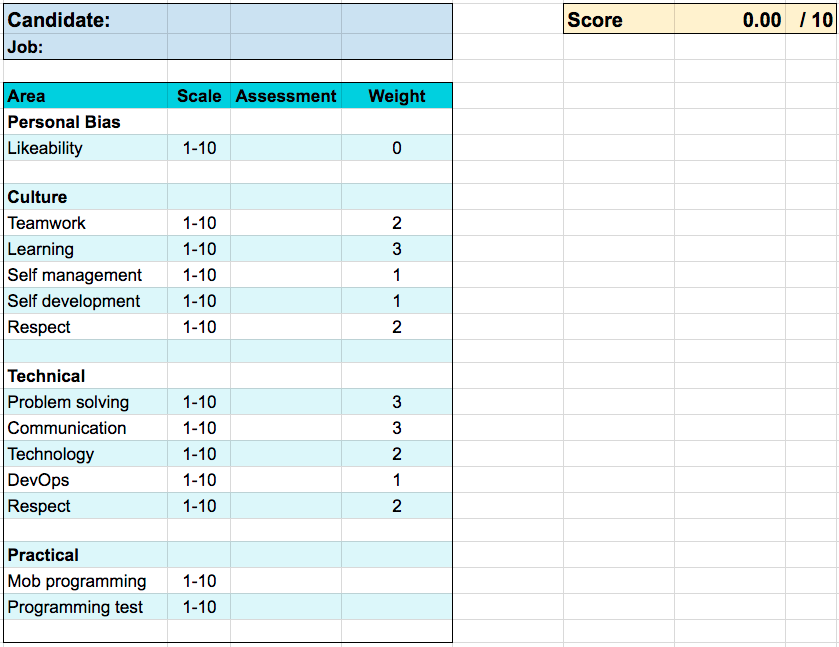
Would you agree that your biases are affecting your recruitment process? We have been thinking about it and we were especially curious how we can improve our recruitment process by working with our biases and learning how to disarm those when hiring.
In this post we are sharing the tools and processes that we found useful. You can try them too!
This year we made various experiments with processes and tools that could help us to work with our biases. These experiments were conducted by two teams in Sweden, over approximately 35 interviews, while recruiting new team members. For each of the tools we are sharing how we use them, and what our experience and assessment of those tools is.
Scorecard
The scorecard is a set of qualities, which a hire/no-hire decision for a candidate is based on. Complementing those qualities is a scoring system (1-10) where each interviewer scores the candidate on those qualities following the interview. The scores can be weighted, according to the importance of the given quality for the role you are hiring for. You can see how this works in the template below.
The scorecard helps to make the assessment of different candidates more comparable to each other. It also goes hand in hand with the standardized interview.
Positive
- Triggers preparation as we need to agree to what factors to put into the scorecard and by that it forces us to be explicit with what factors we are looking for in a candidate
- Made us think through all those factors after an interview - not only what stood out to us or was fresh in memory
- Enabled us to compare candidates more directly
Negative
- Felt a bit boxed in

Standardized Interview
The standardized interview is a defined set of questions that would draw out the information needed to make a decision. When used in conjunction with the scorecard, each area defined in the scorecard would have a set of questions.
As different candidates respond differently to the same question and prove different levels of information, follow-up questions can be used to make sure that the needed information is being retrieved. Furthermore, it is a tool to ensure we don’t linger on a topic that happens to interest both us as the interviewer and the interviewee, stopping us from getting to other areas we should be exploring during the interview.
Positive
- Triggers preparation as the questions (what and why to ask them) need to be defined before the interview
- Ensures that there is at least a similar level of information for each candidate to base a decision on
Negative
- The same question might still trigger very different answers in different candidates, which might induce the feeling of still not having the same level of information to base a decision on (follow-up questions solve that to an extent)
- Can feel limiting at first to stick to a fixed set of questions
Likeability Score
The likeability score is simply a score from 1 to 10 where you score the candidate on how likeable you found that person. We naturally respond to the candidate while interviewing as certain traits or interests might tickle our fancy or put us off, causing us to not being able to assess that person objectively. The likeability score serves to counteract that by making this explicit. When being aware of one’s biases, it’s easier to account for them.
The likeability score is tracked in the scorecard.
Positive
- Bringing the personal chemistry of the one assessing the candidate to his or her awareness: this enables a chance to analyse the interviewers response before assessing
- When used together with a score card, it reminds the interviewee to try to be objective during the scoring
- Very small time investment
Interviewer Diversity
Having some diversity amongst the interviewers can catch attitudes from the interviewee that might not shine through in interview questions. We recommend including people of different positions, authority, ethnicity and gender in the interview process as this allows you to assess any unconscious biases from the interviewee in the actual interview situation.
Patterns in behavior we have discovered by having a diverse set of interviewers:
- Eye contact is made primarily with only one of the interviewers, typically the one with the higher rank, the man instead of the woman etc.
- Answers are given primarily to only one of the interviewers, typically the one with the higher rank, the man instead of the woman etc.
Having a diverse set of interviewers also brings another advantage. Those people will naturally look for different things in a person and react to different parts of an answer. This brings out more factors to consider in the assessment of a candidate.
Conclusion
Just like we are sharing the results of our experiments with you, we have also shared them with other teams in Meltwater already. We hope it will help those teams to remove their own biases while recruiting new team members!
We hope that you find the tools above interesting. If you try them out yourself, we would love to hear about your experience with them! Also if you have any question about how we use them, feel free to comment below.